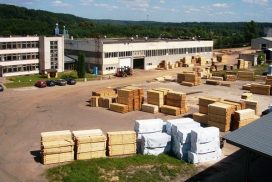The case study of reactive power compensation equipment sizing in a wood processing plant is presented. Analysis performed with EA – PSM software.
Object and technical assignment
Installed apparent power of the analysed wood processing plant is 10.5 MVA. The vast majority of energy consumers are induction motors with 0.8 – 0.85 power factor. Therefore, reactive power consumption exceeds 5.5 MVar during periods of peak demand. Overall rated power of previously installed capacitors is 4.45 MVar, however, measurements and grid analysis have showed that some of the capacitors are not working; other capacitors have 40-80% smaller reactive power than is specified in their documentation. What is more, factory electrical network configuration have changed a lot after existing capacitors were installed, because of this, some of the capacitors need to be relocated.
| THE MAIN PURPOSE OF THIS CASE STUDY IS TO PROPERLY SIZE CAPACITORS FOR PRESENT CONFIGURATION OF THE ANALYSED ELECTRICAL NETWORK AND SPECIFY OPTIMAL LOCATIONS WHERE NEW CAPACITORS SHOULD BE CONNECTED. |
Solution
Wood processing plant network is depicted in figures from 1 to 4. Some induction motors are disconnected, because these schemes represents medium loading conditions. Exact loading of each induction motor is unknown, however, hypothetical values are taken in accordance to energy consumption data and
technological process descriptions.
Fig. 1. Medium and low voltage buses SĮ – 3_I
Fig. 2. Medium and low voltage buses SĮ-4_I
Fig. 3. Medium and low voltage buses SĮ-4_II
Fig. 4. Medium and low voltage busses SĮ-6_II
| AS DEPICTED IN THESE PICTURES, DESPITE REACTIVE POWER COMPENSATION EQUIPMENT IS INSTALLED IN THE FACTORY NETWORK, OVER 1.3 MVAR OF REACTIVE POWER IS CONSUMED AT AVERAGE DEMAND CONDITIONS. |
Capacitors sizing with EA-PSM is performed by calculating load flow, with estimated reactive power capacitors connected to the network, and observing reactive power flows. In case the network still consumes reactive power, capacitors with greater rated power is needed and vice versa.
Analysis results are depicted in Table 1:
| CONNECTION LOCATION* | RATED POWER, KVAR | RATED POWER OF THE SMALLEST CAPACITOR, KVAR | PAYBACK TIME, YEARS |
| TP – 10 | 225 | 5 | 3 |
| TP –16 | 370 | 5 | 3 |
| TP – 8 | 210 | 5 | 4 |
| TP – 10 | 585 | 5 | 5 |
*Titles of busses to which capacitor banks should be connected


